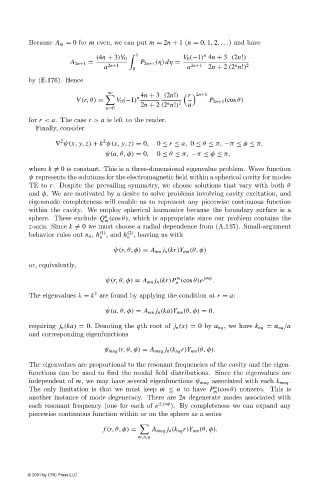Page 514 - Electromagnetics
P. 514
Because A m = 0 for m even, we can put m = 2n + 1 (n = 0, 1, 2,...) and have
1 n
(4n + 3)V 0 V 0 (−1) 4n + 3 (2n!)
A 2n+1 = P 2n+1 (η) dη =
a 2n+1 0 a 2n+1 2n + 2 (2 n!) 2
n
by (E.176). Hence
∞ 2n+1
r
n 4n + 3 (2n!)
V (r,θ) = V 0 (−1) P 2n+1 (cos θ)
n
2n + 2 (2 n!) 2 a
n=0
for r < a. The case r > a is left to the reader.
Finally, consider
2
2
∇ ψ(x, y, z) + k ψ(x, y, z) = 0, 0 ≤ r ≤ a, 0 ≤ θ ≤ π, −π ≤ φ ≤ π,
ψ(a,θ,φ) = 0, 0 ≤ θ ≤ π, −π ≤ φ ≤ π,
where k = 0 is constant. This is a three-dimensional eigenvalue problem. Wave function
ψ represents the solutions for the electromagnetic field within a spherical cavity for modes
TE to r. Despite the prevailing symmetry, we choose solutions that vary with both θ
and φ. We are motivated by a desire to solve problems involving cavity excitation, and
eigenmode completeness will enable us to represent any piecewise continuous function
within the cavity. We employ spherical harmonics because the boundary surface is a
n
sphere. These exclude Q (cos θ), which is appropriate since our problem contains the
m
z-axis. Since k = 0 we must choose a radial dependence from (A.145). Small-argument
(1)
(2)
behavior rules out n n , h , and h , leaving us with
n
n
ψ(r,θ,φ) = A mn j n (kr)Y nm (θ, φ)
or, equivalently,
m
ψ(r,θ,φ) = A mn j n (kr)P (cos θ)e jmφ .
n
2
The eigenvalues λ = k are found by applying the condition at r = a:
ψ(a,θ,φ) = A mn j n (ka)Y nm (θ, φ) = 0,
requiring j n (ka) = 0. Denoting the qth root of j n (x) = 0 by α nq , we have k nq = α nq /a
and corresponding eigenfunctions
ψ mnq (r,θ,φ) = A mnq j n (k nq r)Y nm (θ, φ).
The eigenvalues are proportional to the resonant frequencies of the cavity and the eigen-
functions can be used to find the modal field distributions. Since the eigenvalues are
independent of m, we may have several eigenfunctions ψ mnq associated with each k mnq .
n
The only limitation is that we must keep m ≤ n to have P (cos θ) nonzero. This is
m
another instance of mode degeneracy. There are 2n degenerate modes associated with
each resonant frequency (one for each of e ± jnφ ). By completeness we can expand any
piecewise continuous function within or on the sphere as a series
f (r,θ,φ) = A mnq j n (k nq r)Y nm (θ, φ).
m,n,q
© 2001 by CRC Press LLC

